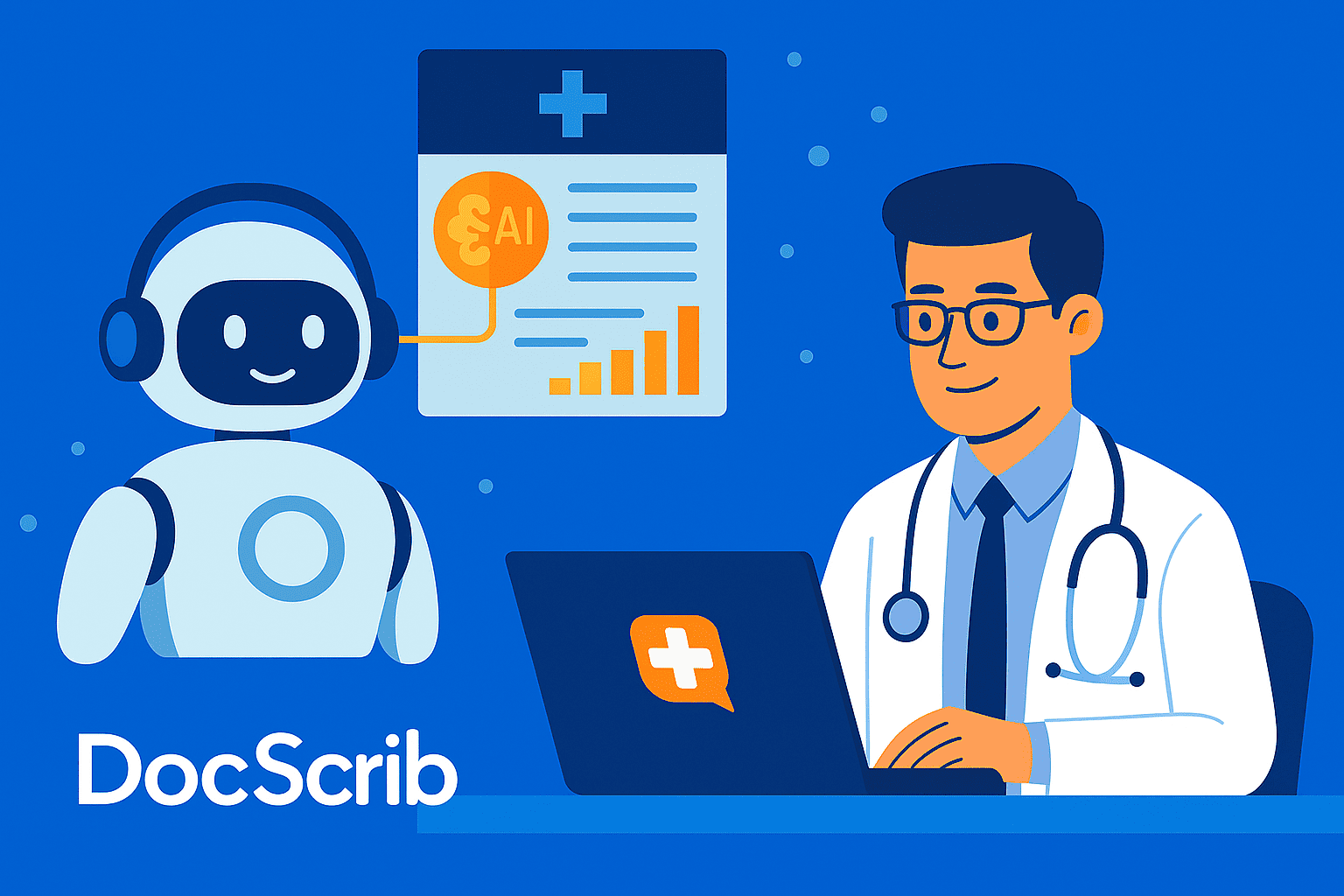Updated on: July 11, 2025
Healthcare documentation is undergoing a transformation. Traditional medical scribes are giving way to AI-powered solutions, but each approach brings trade-offs. Here’s a deep dive into how AI scribes compare with human scribes—and how a hybrid model may reshape workflows.
Understanding the Roles
- Human Scribes: Trained professionals who follow clinicians in real-time, documenting patient encounters in the EHR. Human scribes are often medical students, pre-med graduates, or specialized clerical staff who assist physicians by reducing documentation burdens, allowing providers to focus more on patient interaction.
- AI Medical Scribes: Software tools—often powered by ambient listening, speech-to-text transcription, and Natural Language Processing (NLP)—that automate note-taking. These tools can generate comprehensive SOAP notes, encounter summaries, and discharge reports with minimal human intervention.
- Hybrid Models: Combine AI speed and automation with human validation and oversight to ensure accuracy, empathy, and clinical relevance. This model is increasingly popular in high-volume clinics and telehealth setups.
Performance & Accuracy
| Metric | AI Medical Scribes | Human Scribes |
|---|---|---|
| Transcription Accuracy | 95–98% in controlled environments | ~96% but prone to fatigue and variation |
| Hallucination Rate | ~5–7% risk of inaccuracies or AI “hallucination” | Minimal factual inaccuracies |
| Contextual Understanding | Limited understanding of non-verbal or complex cues | Strong contextual adaptation |
AI scribes excel in consistent data capture and quick turnaround but may struggle with nuance, regional language variations, or highly specialized medical contexts.
Real-World Example: In dermatology, AI scribes handle structured note types with high success rates. In behavioral health, however, human scribes outperform AI due to the need for capturing emotional cues and unstructured conversations.
Efficiency & Time Savings
- AI Scribes can save up to 3 hours daily by automating repetitive documentation, especially for primary care, orthopedics, and telehealth providers.
- Human Scribes save approximately 60–90 minutes daily but require manual entry and post-visit clean-up.
Case Study: A multi-location urgent care chain reported that AI scribes reduced average documentation time per patient from 12 minutes to just under 4 minutes, resulting in over 400 clinician hours saved monthly.
Cost Comparison
| Cost Factor | AI Medical Scribe | Human Medical Scribe |
|---|---|---|
| Monthly Cost | $99–$299 per provider | $2,500–$3,500+ per provider |
| Setup/Training Time | Minimal (2–4 hours) | Several weeks to months |
| Scalability | Instantly scalable | Limited by staffing |
| Maintenance/Turnover | Low ongoing costs | High training/replacement costs |
Example: In a 10-provider practice, switching from human scribes to AI saved approximately $250,000 annually, which was reinvested into patient care and technology improvements.
Impacts on Patient Care
- AI Scribes: Patients report feeling more engaged during visits as providers maintain eye contact, avoid typing during consultations, and focus on interpersonal communication.
- Human Scribes: Human scribes can proactively capture subtle, unspoken details and assist in complex histories but may be intrusive in sensitive cases.
Survey Insights: In a recent patient satisfaction study, 81% preferred AI-driven encounters over traditional note-taking because of improved face-to-face interaction.
Limitations & Risks
AI Scribes
- May misinterpret colloquialisms or specialty-specific jargon.
- Can omit nuanced social histories or psychosocial factors.
- Depend on high-quality audio and stable infrastructure.
Human Scribes
- Human error due to fatigue or distraction.
- Higher long-term costs.
- Potential breach risks from manual data handling.
Hybrid Model: Best of Both Worlds
Hybrid AI-Human Documentation involves AI generating initial drafts, which are then polished by human scribes or clinical staff. This ensures:
- Accuracy
- Contextual sensitivity
- Time efficiency
Example: A hybrid setup in oncology led to a 40% documentation time reduction and a 25% increase in documentation quality ratings.
Clinical Adoption & Real-World Impact
- AI scribes are now used by over 40% of large health systems including leading hospitals and urgent care groups.
- Specialties like radiology, orthopedics, dermatology, and primary care show rapid adoption.
- Telehealth practices, especially in rural or resource-limited settings, prefer AI scribes for cost and scalability.
Case Study: A leading academic medical center adopted AI scribe solutions and achieved a 72% reduction in after-hours charting, leading to a 30% increase in clinician satisfaction scores.
Chart: ROI and Time Savings
| Feature | Human Scribe | AI Scribe | Hybrid Model |
|---|---|---|---|
| Monthly Cost | High ($3,000+) | Low ($200–300) | Moderate ($500–800) |
| Time Savings | ~1 hour/day | ~3 hours/day | ~2.5 hours/day |
| Satisfaction Impact | Moderate | High | Very High |
| Scalability | Limited | Unlimited | High |
Best Practices for Implementation
- Clinical Champion Buy-In: Involve enthusiastic clinicians to promote adoption.
- Customized Templates: Tailor AI documentation templates to each specialty.
- Training Sessions: Offer short onboarding followed by ongoing tips.
- Consent Procedures: Ensure clear patient consent for ambient AI use.
- Periodic Accuracy Audits: Regularly review AI-generated notes for errors or bias.
- Feedback Loops: Incorporate clinician feedback to refine AI outputs.
How DocScrib Complements Both Worlds
DocScrib enhances both AI and human documentation by:
- Offering AI-generated note drafts with optional human edits.
- Providing smart prompts for missing fields (allergies, vitals, history).
- Delivering one-click EHR integration with full audit tracking.
- Ensuring HIPAA-grade security across all interactions.
New Feature Highlight: DocScrib’s new “Voice Command Documentation” allows hands-free control, empowering providers to dictate, edit, and finalize notes in real time.
Final Takeaways
- AI scribes are ideal for cost-conscious, efficiency-driven practices.
- Human scribes still hold value in complex, narrative-rich settings.
- Hybrid models offer the best balance of accuracy, empathy, and affordability.
With tools like DocScrib, healthcare providers can optimize documentation, reduce burnout, and improve patient care while maintaining compliance and data integrity.
Discover how DocScrib can simplify your clinical documentation—book your free demo now and experience the difference!
